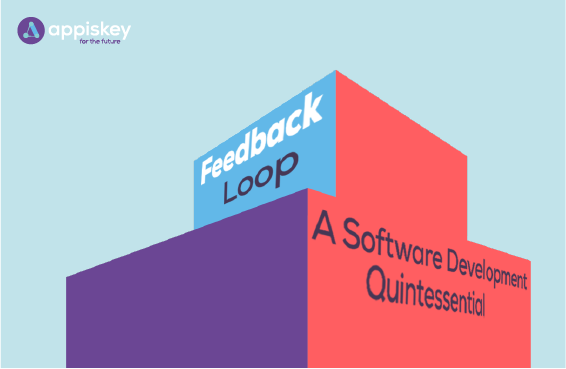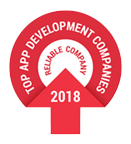Feedback Loop – A Software Development Quintessential

A constructive feedback loop is capable of turning every product’s failure into success.
There’s an adage that software development is only a mix of complex codes, expertise, and a bunch of whatnots. It’s actually an amalgamation between the right techniques, quality, and customer satisfaction. Compromise over any and your product simply wouldn’t survive the competition.
For successful software development, being constantly in touch with peers for constructive feedback pays off quite well. Fellas can learn to overcome shortfalls in their code, equip themselves with development & flow techniques and so much more. However, in a culture where peer collaborations aren’t encouraged, then utilizing feedback loops can be a real challenge.
Feedback Loop – What’s It All About?
Before we get on with the definition of a feedback loop and what lies within, let’s run through a background.
Software developers are always seeking methods that would enhance the quality of their code while meeting the needs of customers. Feedback loops can be a great practice to keep the code looking sharp and customer-centric.
The feedback loop allows developers to experiment, get prompt expert feedback, and experiment some more until the product matches the one they initially intended. In agile development, feedback loops keep the iterative process quick, which ultimately leads to quick feedback, followed by quick product development. More on this in time to come.
Did you know that Silicon Valley giants: HP, Facebook, etc. are more iterative than innovative? Tech experts over there always rely on quick feedback to keep the iterative process progressing smoothly. This practice has been going since quite a while now.
There’s no denying that the feedback loop acts as a great identifier of areas in the code, where some improvement is necessary. For developers, a good and promptly conducted feedback loop goes the extra mile. It provides a great way to practice and overcome coding mistakes until they’ve reached the pinnacle of successful product creation.
Types of Feedback Loops in Software Development
The process of software development is experimental. Therefore, it’s only logical to establish numerous interim checkpoints throughout the process. These checkpoints ensure the final product is exactly what the customers want.
Besides some impeccable coding skills, software development requires time and money as well. Of course, developers wouldn’t mind redoing a project if it were only about expanding their coding acumen. However, with money and time at stake, it can be a real challenge to get the product right and keep investments from turning into losses.
This is where some astute tactics can assist developers in steering the ship away from losses. What are those tactics to be specific? Let’s find out.
Agile Modeling
Agile modeling emphasizes flexibility, collaboration, and rapid iteration.
The feedback loop begins with the creation of a prototype or an initial design that is shared with stakeholders for their feedback. Once feedback is received, the developers improve the initial design with necessary additions, which then formulates a new iteration of the prototype.
This process repeats until stakeholders are satisfied with the design. The feedback loop yielded from Agile Modeling ensures that the whole software development process is iterative, collaborative, and flexible enough to cohere to the needs of stakeholders.
To conclude this section, Agile Modeling keeps the codework constantly improving without much effort. Developers meet with fewer instances of tweaking the code. Plus, the architecture of the software product does not deviate from its specifications, and the overall structure and sanity of the codework also remain well-intact.
Behavior-Driven/ Test-Driven/ Unit Testing
Behavior-Driven Development (BDD), Test-Driven Development (TDD), and Unit Testing work in sync to create a single feedback loop for software development. Let’s talk briefly about each of the techniques individually.
BDD allows developers to ensure that the software in focus reflects the desired behavior. TDD, on the other hand, assists in ensuring that the new features or functionalities incorporated in the software are right according to the specified requirements. Whereas, unit testing identifies bugs early in the development process.
By using these techniques together, developers get to define and stick with the requirements better, build performance-focused APIs, and keep the logic behind code unhindered.
Code Review
Another type of feedback loop is Code Review where developers review each other’s code to identify potential issues. Then they provide feedback to ensure the code stays fully compliant with the coding standards.
Code review is another quintessential for the software development process for it helps in improving the quality of the code and reducing the risk of unknowingly introducing bugs or other issues into the codebase.
Code Review, albeit important, is often ignored by developers for they ‘never have enough time to review their peers’ work’. However, if applied with precision, this particular type of feedback review can enhance the software architecture to a tremendous degree.
Developers make use of several techniques to make Code Review all the more effective. The techniques encompass:
- Using fully automated code review tools
- Establishing clear coding standards
- And providing constructive feedback to developers.
Once these techniques are in the bag, developers can integrate code review into the software development process in a rather efficient and effective manner.
Daily Stand-Up
Now, let’s talk about another type of feedback loop known as Daily Stand-Up. Just as the name suggests, this feedback loop has got a lot to do with daily meetings where developers come together, share their progress, discuss the bottlenecks that they might be facing, and collaborate with other developers to come up with a viable solution.
Since this feedback loop is conducted on a daily basis, the developers get to identify and address potential errors almost instantaneously. This practice prevents the identified errors from morphing into larger, unsolvable bottlenecks down the line.
The final thoughts? A daily stand-up feedback loop facilitates accountability among team members while ensuring that everyone on the team is contributing effectively and efficiently to create a top-quality software product.
Static Code Analysis
This type of feedback loop identifies potential shortcomings in the code that may lead to bottlenecks during runtime. Static code analysis allows developers to perform a comprehensive analysis of the code at various levels. These levels include data flow, semantics, and syntax.
Static Code Analysis utilizes a set of predefined rules or patterns to identify issues in the code such as unused variables, memory leaks, potential violations of coding standards, and security vulnerabilities. By using this type of feedback loop, developers can identify bottlenecks early on in the development process, which keeps the codebase free from bug intrusions.
Additionally, static analysis allows developers to keep the codebase effortlessly rectifiable and easier to understand. All in all, Static Analysis provides a formidable feedback loop technique that not only improves the quality of software applications but also leads developers to use metrics that assist in determining the whole development lifecycle.
Pair Programming
Pair programming is a collaborative feedback loop technique, where two developers – hence, ‘pair’ – work together on a single workstation. While one developer produces the code, the other one meticulously observes and provides real-time feedback.
The feedback loop created through pair programming improves the quality of the code and accelerates the whole development process. Since developers get to work in sync, catching mistakes and issues in the code early on becomes remarkably effortless.
Pair programming also allows developers to identify those areas in the code that could benefit from refactoring or optimization. Additionally, pair programming results in increased team communication and collaboration, since developers can share knowledge and expertise with their peers and get quick feedback.
To wrap it all up, the feedback loop created via pair programming assists developers to improve the quality of their code so that it yields high-impact, performance-focused products each time.
Retrospective
While abiding by the principles of Agile Methodology, retrospective feedback simultaneously enhances the quality of software products and keeps the entire team of developers well-focused. Scrum practitioners call this feedback loop ‘Sprint Retrospective’.
This feedback loop provides an iterative approach to reflecting on past activities, identifying areas for improvement, and taking apt actions to add effortlessness to the whole software development process. The key purpose behind the Retrospective feedback loop is to facilitate team efficiency to ensure the objectives are being timely met.
Long story short – a retrospective feedback loop in the Agile framework fosters an environment of open communication and collaboration where everyone on the project constantly identifies opportunities for improvement.
Fast Feedback Loop – A Quick Intro
The velocity of feedback is just as important as the feedback itself. Therefore, when it comes to speeding up the feedback process, developers resort to fast feedback loops.
Fast feedback loops – just as the name suggests – are aimed at reducing the time between writing code and identifying potential errors. This practice allows developers to introduce a rapid fix to the issues in codework in a rather efficient manner.
The Fast Feedback Loop is also called the Agile feedback loop. It keeps the productivity levels of everyone involved in the development process, unhindered. Moreover, the agile feedback loop facilitates a mechanism that improves the quality of the product through quick feedback.
The final word is? Agile feedback or fast feedback loop promotes iterative development and gives everyone something new to learn along the way.
Why Is It Important to Leverage Fast Feedback Loop in Agile Development?
Before we discuss the importance of a feedback loop in agile development, it seems only logical to quickly run through the Agile Development itself.
Agile Development – At a Glance
Developers place a great deal of value in Agile development for all the benefits it packs. First of all, it allows teams to make quick upgrades to the product as per new requirements and customer feedback. This allows the final product to adhere to customers’ needs, and yield higher customer satisfaction.
Secondly, agile development encourages collaboration between developers, project managers, and stakeholders, resulting in better communication, and more effective decision-making. And finally, it promotes a culture of continuous improvement.
Fast Feedback Loop in Agile Development – The Actual Discussion
Keeping track of performance and looking for new ways to improve, are probably two of the most important factors that keep organizations afloat in the increasingly competitive landscape. And, the best way organizations can achieve that is through fast feedback loops.
Since an agile organization is keen on constant iterations, fast feedback loops can actually assist in making the whole process easy. Think of it this way – the faster developers highlight weak areas in the product, the faster they’ll be able to make tweaks and release it into the market.
Adopting a fast feedback approach encourages a culture of constant learning and growth. Rather than focusing on getting projects out of the way quickly, fast feedback allows developers to place value in acquiring knowledge and implementing it to produce better results. Moreover, fast feedback also makes the developers greatly resilient to rapidly altering trends and practices, rather than settling for existing ones.
Another effective tool for implementing fast feedback in agile development is the Scrum feedback loop. The sprint review in the Scrum feedback loop allows the development team to act on feedback as soon as the review is in.
There’s something about traditional feedback methods that developers deem as productivity drainers. There’s often a painfully long lag between gathering feedback and devising an action plan which ultimately leads developers into “survey fatigue”.
Therefore, as a general rule of thumb, staying well-versed with the latest feedback-gathering practices – agile & scrum – keeps the feedback loop short, and developers get to implement new changes in a much more efficient way.
What Ways Can Fast Feedback Loops Be Improved in an Agile Environment?
In an agile environment, a fast feedback loop fosters a collaborative work environment. To ensure this feedback-gathering practice remains unhindered in any organization, there are some trusted strategies that can be applied to each project. Without any ado, here they are:
Keep the Feedback Loop Going with Timely Post-Sprint Meetups
Petition to make reviewing every sprint meetup a norm. Who’s with us? After every sprint, conducting a quick review sesh with the teammates can yield some valuable feedback.
It’s a bummer to see how many organizations don’t take this up as a regular practice because post-sprint reviews are assumed to be time-consuming. Well, they’re simply not.
Don’t forget. When there are less frequent meetups, small issues often remain unattended, and later on, they turn into bigger problems. Therefore, engaging in a feedback loop with the team after each sprint keeps the product feedback-focused, and customer-centered.
Add Muscle to Feedback Loop with Sprint Retrospectives
Don’t confuse this with the previously mentioned post-sprint meetups. Sprint retrospective allows the team to gauge their performance and progress based on the following questions:
- What went wrong?
- What went right?
- And, are there any improvements needed?
The answers to these questions are more like an overview of the upcoming actions. Once these questions have been asked, every developer on the team has to devise an actionable strategy and get to work on it right away. The results of this current sprint retrospective would become a part of the future sprint, and so on.
Feel Free To Ask As Many Targeted Questions As Possible
Open-ended questions sometimes generate the best kind of solution, rather than close-ended ones that lead the team nowhere.
During the feedback loop, developers are encouraged to ask good, well-thought-out questions that speak tons of the product. The questions can be related to the product’s problem-solving feature. The convenience it offers to the users. Or any important feature or functionality that may have gone missing.
Remember, the more questions there are, the better the end product would be.
Treat User Testing as a Vital Feedback Loop Component
What good is a newly added feature if users don’t like it? This definitely takes us back to when Instagram ended up in hot waters for its Tik-Tok-like features. The backlash was so intense that the world’s favorite photo-sharing platform had to act quickly to revert back to its non-Tik-Tok self.
Anywho, to avoid running into such snafus, it’s best that the team readies a prototype of the product to understand what the users think about it. And to determine how easy it is to use. The developers then release the prototype to a small group of select users for their feedback. The user feedback goes in to make alterations to the product, and this goes on until the product has fully met expectations.
This practice, albeit a bit tedious, can create an impactful, high-quality product.
Encourage Actionable Opportunities
The key purpose behind engaging in a fast feedback loop is to allow developers to continuously improve the product based on the feedback received.
This practice unlocks opportunities for employees to add efficiency to their performance, enhance their collaborative skills, learn about teamwork, and most importantly, feel appreciated by their employer.
Engage Remote Employees in the Feedback Loop
The most important one, for the last. Since remote working has become a common practice these days, the need to emphasize the feedback loops in this situation cannot be stressed enough.
For teams and individuals working remotely, engaging everyone in a scrum feedback loop should become a daily ritual. With video conferencing tools such as Zoom, Google Meet, MS Teams, etc. conducting sprints with remote employees has become all the more effortless. Similarly, for feedback collection, team members can resort to MS Teams and Slack.
With so many viable solutions out there, the sky really has become the limit when it comes to maintaining feedback loops with remote teams.
Long Feedback Loop – Painstakingly Slow, Where No Developer Wants to Go
So, what did we learn so far?
Fast feedback loops are the key to effortless software development that yields a high-quality product. But, what happens when there’s a delay in the feedback loop?
A delayed feedback loop or Long feedback loop can be a frustrating thing when there is a team’s time and productivity at stake.
Long feedback loops – just as the name suggests – happen when there’s a delay between the feedback received and the actions necessary to take. Long feedback loops can make everyone involved in the development process feel extremely demotivated. Plus, getting the product ready and releasing it into the market also seems like a long shot.
What Causes Delay in Feedback Loops?
Long feedback loops occur due to various factors, such as:
- Lack of clear communication
- Lack of best software practices
- Paying zero attention to the Agile framework
- Slow response times
- Complex decision-making processes
- Non-resilient & rigid organizational structures
- No technical skills
- Utilizing outdated tools & practices
The Consequences of a Long Feedback Loop
A good quality code is the fastest way to push software into the production phase. In the longer run, quality code also makes maintenance remarkably easy. However, in the case of a long feedback loop, estimating the time of the overall production becomes really difficult. Plus, there are also other consequences that long feedback loops lead to. Such as:
Delays
Long feedback loops can lead to delays in the development process, as issues are not addressed quickly enough. Plus, the development team ends up wasting a lot of valuable time while waiting for feedback. Because unless there’s feedback, there’s no way developers can proceed.
Mediocre Quality Code
When feedback takes a long time, it can be difficult to address issues on a timely basis. This inevitably leads to lower-quality code and because of that, the end product would fail to meet user needs.
Lessened Productivity Levels
Waiting for feedback keeps developers from moving forward with their work. This results in overall productivity going downwards.
Misaligned Expectations
Long feedback loops lead to misaligned expectations between the development team and stakeholders, as feedback may not accurately reflect user needs or may be outdated.
Higher Development Costs
And finally. Long feedback loop leads to longer development cycles. And longer development cycles lead to higher costs, as more time and resources would need to hop on board to address the issues and provide relevant changes.
Ending the Loop with a Conclusion
The feedback loop makes for an essential software development component that one can’t simply ignore. It adds refinement to ideas so that the end product turns out exactly how the developers envision it.
By stressing the importance of a feedback loop, software organizations can foster a culture where continuous improvement never ceases, where mistakes are deemed as opportunities for growth, and success is measured by the constant drive to adapt and evolve with the new changes.
Your Feedback Feeds Us!
Has this article hit the mark, or is there something missing? Feel free to share your feedback with us at feedback@appiskey.com.















